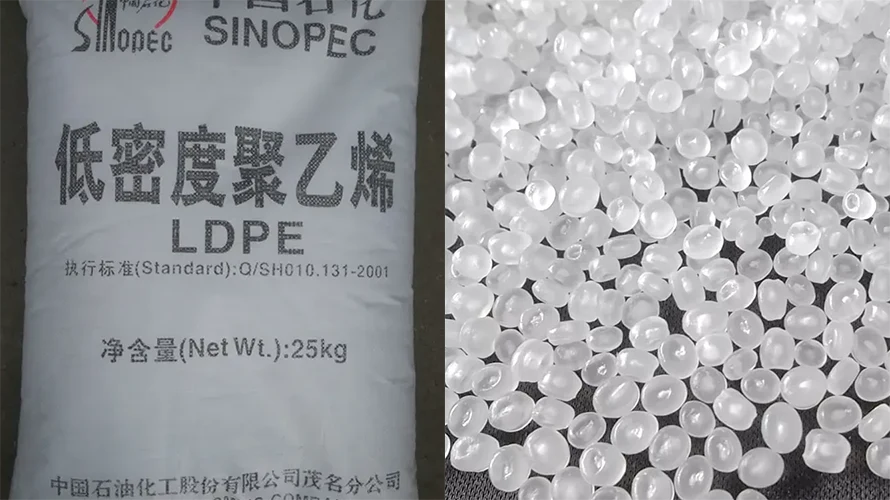A quick overview of the topics covered in this article.
Subscribe to the UKPACK newsletter to receive regular updates on the company, products, services, upcoming exhibitions and more.
The versatility and unique properties of LDPE Plastic, also known as Low Density Polyethylene, has made it a widely used material across various industries. From packaging and agriculture to construction and consumer goods, LDPE plastic has established itself as a necessary component of modern society.
Nevertheless, the environmental impact of its utilization has sparked concern, highlighting the importance of comprehending its characteristics and responsible usage by both industry professionals and consumers alike.
In this comprehensive guide, we delve deep into the intricacies of LDPE plastic, exploring its historical background, physical and chemical properties, applications, recycling processes, environmental impact, and future outlook.
Whether you’re a seasoned industry expert or a curious learner, this article provides a thorough examination of all things LDPE plastic.
What is LDPE Plastic?
LDPE, the abbreviated term for Low Density Polyethylene, is a type of thermoplastic that has garnered widespread recognition across a spectrum of industries due to its inimitable attributes.
This incredibly versatile material finds widespread use in packaging, agriculture, construction, and consumer goods.
The hallmark of LDPE plastic is its low density, which endows it with a remarkable degree of flexibility and suppleness, permitting it to be molded into a multitude of shapes and sizes with ease.
What are the Properties of HDPE
LDPE plastic has a number of distinct characteristics, such as:
Low Density
Its low density, which ranges from 0.910 g/cm3 to 0.940 g/cm3.
Low density is one of the defining characteristics of LDPE plastic. It is a type of thermoplastic material that is known for its unique combination of properties, including flexibility, softness, and ease of molding.
The low density of LDPE plastic is a result of its molecular structure, which is characterized by long chains of polymer molecules that are loosely packed. This molecular structure allows LDPE to have a lower density compared to other types of plastic, making it one of the most lightweight and flexible materials available.
The low density of LDPE plastic is particularly useful in a variety of applications, such as:
- Packaging industry: Bags, bottles, wraps, and covers.
- Agriculture: Greenhouse covers, silage covers, and mulch films.
- Construction: Waterproofing, roofing membranes, and vapor barriers.
- Consumer goods industry: Toys, electrical cable insulation, and rainwear.
Chemical resistance
LDPE boasts a remarkable attribute of chemical resistance, allowing it to withstand the corrosive and reactive nature of various substances. This makes it a suitable material for use in challenging and harsh industrial settings, particularly in the chemical and pharmaceutical industries where it’s used to store, transport and protect delicate compounds and medicines.
Additionally, LDPE’s chemical resistance is leveraged in the production of containers, bags, and liners, providing an impenetrable barrier to keep contents safe from potential contamination and harm. Discover the versatility and robustness of LDPE, a material poised to meet the demands of even the toughest industries.
Impact Resistance
The impact resistance of LDPE plastic is a highly sought after characteristic in various industries and applications. Its remarkable strength and toughness make it an ideal choice for products that must endure rough handling and exposure to harsh conditions.
From heavy-duty transportation liners, to burly bags for carrying loads, to rugged covers for machinery and equipment, LDPE proves its mettle time and again with its exceptional performance and longevity.
Whether you require a reliable material to guard delicate items during transit or a durable shield against the elements, LDPE plastic stands as a versatile and trustworthy choice.
Low-Temperature Resistance
Unleash the Power of Polyethylene in the Freeze! LDPE’s remarkable capacity to keep its shape and remain flexible in temperatures as low as -70°C has made it the go-to material for applications requiring flexibility and sturdiness in frigid climes. From freezer bags to refrigeration pipes, LDPE delivers exceptional performance even in the frostiest of temperatures.
And with its ability to maintain dimensional stability, it’s no wonder LDPE is a popular choice for cold storage facilities and in protecting goods from temp fluctuations. Don’t let the cold slow you down – embrace the power of LDPE!
Moisture Barrier
LDPE’s remarkable moisture barrier attribute propels it to the forefront in various industries as a solution to keep products, like food, pharmaceuticals, and consumer goods, protected from moisture-related damage and spoilage.
Its unique molecular composition, comprising tightly interlinked polymer chains, prevents moisture from permeating and reaching the protected item, thereby maintaining its freshness and quality.
The moisture-resistance of LDPE makes it an optimal choice for packaging and storage applications, with widespread usage in food packaging, such as wraps, bags, and containers, and in pharmaceutical packaging, where it shields delicate medications from moisture harm.
Food Safety
LDPE plastic’s reputation as a safe option for food contact stems from its non-toxicity, steadfast chemical stability, and immunity against bacteria and other dangerous microorganisms.
This prized thermoplastic has received the green light from the FDA for use in food packaging and has undergone rigorous assessments to guarantee that it won’t release any detrimental chemicals into food. Its compatibility with microwaves and dishwashers elevates its practicality and versatility in household food storage.
What is LDPE Plastic Used for?
LDPE, the wonder-plastic of Low Density Polyethylene, boasts a myriad of applications that are driven by its exceptional toughness and versatility. With its hallmark ability to endure, LDPE is widely favored for the production of containers, bottles, tubing, computer parts, laboratory equipment, and various caps and closures.
Beyond its sturdy characteristics, LDPE is also prized for its pliability, making it the go-to material for the manufacture of plastic bags for both food and dry cleaning purposes. Its unbreakable qualities provide the necessary protection and preservation of freshly cleaned clothes and food items.
In the commercial sector, LDPE shines as a plastic film and packaging material, leveraging its transparency and robustness to safeguard a range of products from external elements.
Whether it’s food items or consumer goods, LDPE offers a formidable barrier, elongating the shelf life of the contained products and preserving their quality.
What is the Difference Between LDPE and HDPE Plastic?
Despite being closely related, LDPE and HDPE exhibit distinct characteristics that set them apart. Here are the several differences between the two materials:
- Density: As the names suggest, the main difference between LDPE and HDPE is their density. LDPE has a lower density than HDPE, which results in a softer and more flexible material.
- Chemical Resistance: HDPE is more chemically resistant than LDPE, which means it is less likely to be affected by chemical exposure. This makes HDPE a good option for containers that will store chemicals.
- Tensile Strength: HDPE has a higher tensile strength than LDPE, which means it can withstand greater stress without breaking. This makes HDPE a good choice for applications that require a high level of strength, such as pipes and outdoor furniture.
- Impact Resistance: HDPE has a higher impact resistance than LDPE, making it a better option for products that need to withstand repeated handling or exposure to harsh conditions.
- Heat Resistance: HDPE has a higher heat resistance than LDPE, which means it can withstand higher temperatures without deforming.
The choice between LDPE and HDPE depends on the specific requirements of the application. While LDPE is more flexible and has lower density, HDPE is stronger, more chemically resistant, and has a higher heat resistance.
How to Recycle LDPE Plastic?
Recycling LDPE plastic is a process that involves collecting, sorting, cleaning, and reprocessing used LDPE plastic products into new materials. Here is a general outline of the process:
- Collection: Used LDPE plastic products are collected from homes, businesses, and other locations. They are often collected in recycling bins and then taken to a recycling facility.
- Sorting: The collected LDPE plastic is sorted by type, color, and other factors to ensure that it is processed with similar materials.
- Cleaning: The sorted LDPE plastic is then cleaned to remove any contaminants, such as food residue, dirt, and other debris.
- Shredding: The cleaned LDPE plastic is then shredded into small pieces to prepare it for processing.
- Melting: The shredded LDPE plastic is melted and molded into pellets, which are then cooled and solidified.
- Reprocessing: The LDPE plastic pellets are then used as raw material to produce new products, such as containers, packaging, and other plastic items.
How to Recycle LDPE Plastic?
Recycling LDPE plastic is a process that involves collecting, sorting, cleaning, and reprocessing used LDPE plastic products into new materials. Here is a general outline of the process:
- Collection: Used LDPE plastic products are collected from homes, businesses, and other locations. They are often collected in recycling bins and then taken to a recycling facility.
- Sorting: The collected LDPE plastic is sorted by type, color, and other factors to ensure that it is processed with similar materials.
- Cleaning: The sorted LDPE plastic is then cleaned to remove any contaminants, such as food residue, dirt, and other debris.
- Shredding: The cleaned LDPE plastic is then shredded into small pieces to prepare it for processing.
- Melting: The shredded LDPE plastic is melted and molded into pellets, which are then cooled and solidified.
- Reprocessing: The LDPE plastic pellets are then used as raw material to produce new products, such as containers, packaging, and other plastic items.

Lucas Ji, Founder of UKPACK and Chief Packaging Designer, has 15 years of experience designing sustainable packaging for global beauty and beverage brands. His Red Dot Award-winning solutions have helped 50+ premium brands transition to eco-friendly packaging.

